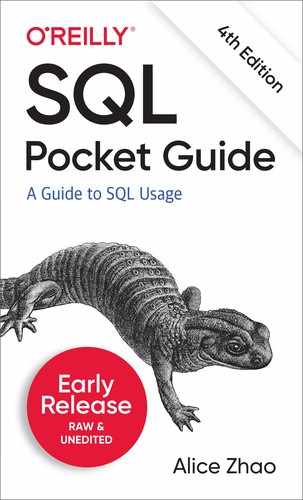Preface
Why SQL?
Since the last edition of the SQL Pocket Guide was published, a lot has changed in the data world. The amount of data generated and collected has exploded, and a number of tools and jobs have been created to handle the influx of data. Through all of the changes, SQL has remained an integral part of the data landscape.
Over the past 15 years, I have worked as an engineer, consultant, analyst and data scientist, and I have used SQL in every one of my roles. Even if my main responsibilities were focused on another tool or skill, I had to know in SQL in order to access data at a company.
“If there was a programming language award for best supporting actor, SQL would take home the prize.”
As new technologies emerge, SQL is still top of mind when it comes to working with data. Cloud-based storage solutions like Amazon Redshift and Google BigQuery require users to write SQL queries to pull data. Distributed data processing frameworks like Hadoop and Spark have sidekicks Hive and Spark SQL, respectively, which provide SQL-like interfaces for users to analyze data.
SQL has been around for almost five decades, and it is not going away anytime soon. It is one of the oldest programming languages still being used widely today and I’m excited to share the latest and greatest with you in this book.
Goals of This Book
There are many existing SQL books out there ranging from ones that teach beginners how to code in SQL to detailed technical specifications for database administrators. This book is not intended to cover all SQL concepts in depth, but rather to be a simple reference for when:
-
You’ve forgotten some SQL syntax and need to look it up quickly
-
You’ve come across a slightly different set of database tools at a new job and need to look up the nuanced differences
-
You’ve been focusing on another coding language for a while and need a quick refresher on how SQL works again
If SQL plays a large supporting role in your job, then this is the perfect pocket guide for you.
Updates to the Fourth Edition
The third edition of the SQL Pocket Guide by Jonathan Gennick was published in 2010, and it was well-received by readers. I’ve made the following updates to the fourth edition.
-
The syntax has been updated for MySQL, PostgreSQL, Microsoft SQL Server and Oracle. IBM’s DB2 has been removed due to its decrease in popularity and SQLite has been added due to its increase in popularity.
-
The third edition of the book was organized alphabetically. I rearranged the sections in the fourth edition so that similar concepts are grouped together. There is still an index at the end of the book that lists concepts alphabetically.
-
Due to the number of data analysts and data scientists who are now using SQL in their jobs, I added sections on how to use SQL with Python and R (popular open source programming languages), as well as an SQL crash course for those who need a quick refresher.
